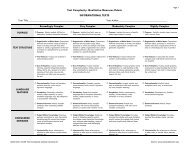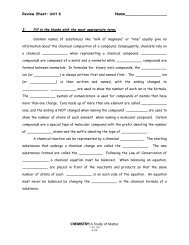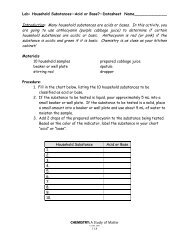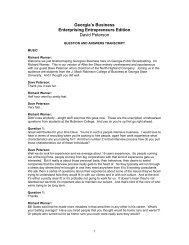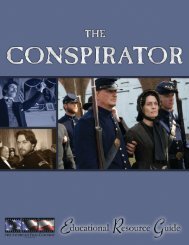PDF Transcript - Georgia Public Broadcasting
PDF Transcript - Georgia Public Broadcasting
PDF Transcript - Georgia Public Broadcasting
Create successful ePaper yourself
Turn your PDF publications into a flip-book with our unique Google optimized e-Paper software.
Script: 1408 Insects Page 1 of 12Original Airdates: @ 6 PM and @ 12:30 PMVideoAudio. >>MALE NARRATOR:WITH OVER 6 MILLION SPECIES CRAWLINGAROUND, INSECTS ARE THE TRUE RULERSOF THE EARTH. ON THIS EPISODE, WE’LLLEARN ABOUT SOME OF GEORGIA’S BUGS,PLUS, WE’LL LEARN TO TIE A FLY AND GOFLY FISHING FOR TROUT. COMING UP ONGEORGIA OUTDOORS>>NARRATORNO GROUP WITHIN THE ANIMAL KINGDOMIS AS PERVASIVE AS THE INSECT. FROMTHE BEAUTIFUL, TO THE NOT SOBEAUTIFUL, THESE 6 LEGGED CREATURESINHABIT NEARLY EVERY SQUARE FOOT OFOUR LANDSCAPE. THOUGH WE OFTENDON’T NOTICE THEM UNTIL THEY INVADEOUR HOMES OR GARDENS, THEY ARECONSTANTLY AT WORK: EATING, WORKINGAND YES – MULTIPLYING. EACH YEAR, THEUNIVERSITY OF GEORGIA AND THE STATEBOTANICAL GARDENS HOST AN UNUSUALEVENT TO HONOR THESE ARTHROPODS –THE INSECTIVAL WHERE YOU CAN GET ANUP CLOSE LOOK AT SOME OF THESEINVERTEBRATES, CATCH A BUG RACE, ORFOR THOSE WITH AN ADVENTURESOMEPALATE, MAYBE EVEN HAVE A TASTE OFONE!>>Kudon: About 30 years ago i did a seminar oncooking insects and that was the first time i did itand I’ve been doing it ever since.>>(To Group) You’re going to brave? This isdelicious food. You’re brave if you don’t eat it!>>The fun thing about it is every time we do this,we come up with new recipes, new ways to cookinsects. We take feta cheese and garbanzo beanswith some oatmeal and we add our finest groundroast cricket abdomens and some garlic and pepper.
Script: 1408 Insects Page 2 of 12Original Airdates: @ 6 PM and @ 12:30 PMWe sauté it in olive oil with a slice garlic of andadd some lime and then we serve it between wholewheat bread with a caper on top, my adobocranberry sauce and this is black bean salsa saladwith meal worm crunchies.>>Man (to Kudon): Give me a worm. I gotta atleast have a worm.>>Kudon (to Man): There’s one in there.>>The first reaction is “Ick!” But when they tasteit, people are surprised because actually what wetry to do is get things that taste very good and theyusually like it. And the kids, most kids when theytaste it, you can’t stop them from eating it becauseit’s pizza, it’s chocolate chip cookies.They are low in a lot of the fats that cause problemsfor people so they’re a good source of protein.Meal worms are easy to prepare. You know, onceyou get them, all you have to do is really rinse thenand cook them. And if you just fry them in a littleoil and add some salt, you call them southern friedmeal worms. They taste nutty and you can eat themwhile you’re watching TV.>> (to girl): Now tell the truth. Did you like that?Was it good?>>NARRATOR: INSECTS DON’T HAVE TO BESAUTÉED TO BE INTERESTING. WE’VEASKED HEATHER HEIMER, A TEACHER ATFERNBANK SCIENCE CENTER, TO TEACH USA LITTLE ABOUT LIVE INSECTS.>>Heimer:An insect is a type of invertebrate. It’s in the arthropodgroup. All arthropods have a couple things in common. Theyhave jointed appendages, which means, basically, they havelegs that can bend, and most importantly, they have anexoskeleton, which is like a suit of armor that covers theentire body of the animal and offers them protection.>>NARRATOR:OTHER MEMBERS OF THE ARTHROPODGROUP INCLUDE THE AQUATICCRUSTACEANS LIKE LOBSTERS AND
Script: 1408 Insects Page 3 of 12Original Airdates: @ 6 PM and @ 12:30 PMCRAYFISH, CENTIPEDES AND MILLIPEDES,AND THE SECOND MOST POPULOUS GROUPNEXT TO INSECTS, THE ARACHNIDS, WHICHINCLUDE TICKS, SCORPIONS AND, OFCOURSE, THE SPIDER. SPIDERS OFTENINVOKE OUR FEAR, BUT THEY AREIMPORTANT MEMBERS OF THE ECOSYSTEM.>>Heimer: In <strong>Georgia</strong> we have many differenttypes of spiders. Of course we have some spidersthat build beautiful webs. Some spiders don’t evenmake webs at all. Many spiders just live on theground, in the grass, in burrows. There’s waterspiders. There’s all sorts of different habitats thatthey might be found in. and it’s true that all spiders,with the exception of just a few in the world, arevenomous. But most of them do not have a bite thatcan harm a human, either because the venom is toomild or because their fangs really can’t penetrateour skin. So the only two we really have to worryabout are the black widow spider and the brownrecluse spider. Those are two that actually do havea strong enough venom to cause us a little bit oftrouble. But usually if you just get to a doctor andget treated quickly they’re not usually a deadlyspider. And they do tend to be pretty secretive andnot ones that we encounter very often, so there’sreally not too much to be afraid of if you see aspider in your home.>>NARRATOR: THE EASIEST WAY TO TELLAN ARACHNID FROM AN INSECT IS BY LEGCOUNT. ARACHNIDS HAVE EIGHT LEGS,WHEREAS INSECTS HAVE ONLY 6, AND THEINSECT GROUP IS BY FAR THE MOSTPOPULOUS ANIMAL GROUP ON THE PLANET.>>Heimer: Insects are grouped into different orders, whereeach order is going to have certain things in common. Someexamples would be ants and bees and wasps, all in a group.Butterflies and moths are grouped together. And of course,then there’s the largest insect order, the beetles.>>Narrator:With over 200 Million insects for everyhuman on earth, these 6-legged creatures
Script: 1408 Insects Page 4 of 12Original Airdates: @ 6 PM and @ 12:30 PMare everywhere. Some species such asbees, ants, and wasps build intricate nestsand have developed complex socialsystems. Others lead more solitary lives.<strong>Georgia</strong> is home to a variety offascinating insects>>Heimer: Because <strong>Georgia</strong> is so warm, we do have a widevariety of different type of insects, and insects can occupyhabitats, um, any place from a very dry habitat to actually inthe water, up in the trees, under the ground, and pretty muchall over our state. A lot of times in the summers we do hear aloud buzzing the trees and those are the cicadas, and they arevery common here in <strong>Georgia</strong>. And a lot of children arefamiliar with them by finding little exoskeletons, little moltsstuck to the sides of trees.Another really interesting insect are the water striders that wesee very often if you ever go out canoeing or you have a pondbehind your house. You may see little insects that look they’realmost skating on top of the water, and what they do is by beingso light weight and by spreading their legs out far like that,they’re displacing their body weight to the point that they canactually move around on the surface tension that exists betweenthe water molecules. And so, they actually will use little bits oftrembling of their feet to communicate by rippling the waterwith each other and also to avoid collision.One really interesting animal I think of when I think of insects isthe dragonfly. They really are the best fliers in the insect worlds.Um, they’ve been clocked up to thirty-five miles an hour. Theycan swoop, dive, change direction in an instant, and they’veactually been studied even by some military in the U.S. Theyput them in wind tunnels to try to figure out ways to designhelicopters and airplanes better by looking at the way that theyfly. They’re also sometimes known as mosquito hawks becausethey are such great predators of mosquitoes. So, they’rewonderful to have around and of course they use their flyingskills to be able to catch mosquitoes on the wing, which meansin flight.
Script: 1408 Insects Page 5 of 12Original Airdates: @ 6 PM and @ 12:30 PM>>Narrator: Insects are pretty low on thefood chain, so many have developedcreative ways to avoid becoming a tastymeal.>>Heimer: A lot of insects do mimic other things, perhaps tofrighten away predators. Um, sometimes insects will havethings that look like big eyes on them to hopefully scare awaya predator into thinking that it’s the face of some large animalinstead of a small insect. And sometimes insects will looklike other insects that are dangerous even when theythemselves aren’t. But there are a lot of insects that havenatural defenses, like, of course, bites and stings also justbright coloration to warn of toxic chemicals that might be intheir body that make them bad to eat. Probably the mostimportant thing that they use to protect themselves iscamouflage; not having bright colors but having drab colorssometimes that blend in really well with the surroundingenvironment, like the leaves and the trees on the ground orperhaps matching the color of bark that they sit on or aparticular flower.Praying mantises are another really interesting insect that we dohave quite a few of around in <strong>Georgia</strong>. They are a carnivorousinsect, meaning that they do eat other insects, and they’reexcellent hunters. They have really good eyesight; they’re verymaneuverable, very fast when they need to be. Of course, theyhave an excellent way to camouflage themselves by looking likea stick and blending in, so that a lot of times the poor insect thatit catches, the prey never saw it coming because it did just thinkit just landed beside a stick.>>Narrator:In addition to other insects, prayingmantises have been known to eat frogs,small rodents, and even birds. In fact, noteven other mantids are safe. Aftermating, a female praying mantis maymake a meal of the male.>>Heimer: A lot of insects, of course, are nocturnal; theycome out at night. So it’s also a good time for a lot ofnocturnal animals that come out at night that feed on insectstoo. A lot of the nighttime sounds that we’re used to hearingare made by insects like crickets and katydids. Of course,
Script: 1408 Insects Page 8 of 12Original Airdates: @ 6 PM and @ 12:30 PMwhere plants can use them again.Often times we are afraid of insects, and we certainly don’t wantthem around, don’t want them in our house, don’t want themon our bodies. But insects are very important. They do a lot ofgood. The earth really couldn’t survive without them. Theyperform services for us like pollination and decomposition.And without them we would be in big trouble.>>Female N arrator: The N orth American ButterflyAssociation’s mission is to increase public enjoyment andconservation of butterflies. N ABA butterfly counts is anongoing program of N ABA to census the butterflies ofN orth America and to publish the results. Volunteerparticipants select a count area with a 15-mile diameterand conduct a one-day census of all butterflies sightedwithin that circle. The counts are usually held around July4 th for the US. Write to this address or visit this website ifyou are interested in participating in a day of butterflycounting.>>Male Narrator: Insects do not begintheir lives in their adult form. All beginas eggs, and go through one or two morephases before reaching adulthood…Thebutterfly egg becomes a caterpillar andthen undergoes what is perhaps the moststriking transformation in the insectworld. Many insects actually begin life ina completely different habitat.>>Heimer: Many, many insects do get their start in life, um, aswater dwellers. A lot insects lay their eggs in or around thewater, and then the larvae will develop as something that lives inthe water and preys on, perhaps, other insects that live in oraround water. Some even prey on minnows. A lot of fish, ofcourse, use these insects that live in the water and some as thisinsect larvae as a great source of food too, especially a lot of thesmaller fish; they will prey on the insects first, and that doeskind of form the basis of a water food chain as well.>>NARRATOR:THE ART OF FLY FISHING RELIES HEAVILYON KNOWING HOW THIS FOOD WEBOPERATES. GEORGIA IS HOME TO SOME OFTHE BEST FLY FISHING IN THE SOUTH, BUTBEFORE YOU GET OUT ON THE RIVER, YOUHAVE TO KNOW HOW TO TIE A GOOD FLY.WE JOINED DON PFITZER AND HIS FRIENDJOSHUA BARNETT TO LEARN MORE ABOUTTHIS INTRICATE ART FORM.
Script: 1408 Insects Page 9 of 12Original Airdates: @ 6 PM and @ 12:30 PM>>Pfitzer: And the whole purpose for this is so that you can seethe fly. Fly tying is a fascinating hobby, but why do you tie flies?And the whole purpose is: fly fishing with a fly rod and for troutparticularly, you need something that will bring that lure to thewater accurately. Well the fly does that. And it’s made out of alot of different materials: hair, string, feathers of all kinds. It’sjust a wide variety of materials that will make a fly, but thewhole purpose is to imitate some sort of insect or some sort offood that the trout is feeding on. We can tie a fly that looks likea minnow; you can tie a fly that looks like a cadis-fly.The trout sometimes like red on their flies, and some of theearlier fly-tyers found this out and learned to use it that way ofcourse.The tying of takes several little pieces if equipment, a vice and abobbin, and to tie the thread, tie the materials on to a hook.And the flies are usually very small compared to bass fishinglures and, and crappy fishing lures. They’re very small. Thehook sizes are so tiny some times it takes magnification just totie the pattern that you want.Josh is one of those young fellas who learn to tie flies right. Hedoes a beautiful job. His hands have been described as beingsurgeon’s hands as he deals with, the threads and the feathersand the things on that attach on the hook of the fly. And helikes to fish! So the whole combination is just a wonderful thingfor a youngster like Josh to be involved with because peoplewho are interested in the out of doors, generally, don’t get introuble.Fly tying became a fun thing for me; I’m not a fly tier by trade,and anybody who’s seen me tie flies, knows that I’m not a greatfly tier, but they catch fish, and that’s what counts.
Script: 1408 Insects Page 10 of 12Original Airdates: @ 6 PM and @ 12:30 PM>>Narrator: In order to tie a fly that willcatch a fish, you need to know what foodthe fish are expecting. Experiencedfishermen call this “Matching the Hatch”Don and Josh have enlisted the help ofChattahoochee river guide Chris Scalleyto learn more.>>Scalley: Matching the hatch; that’s what every angler’sdream is to figure out exactly what’s on the menu with troutin the river. And if you can figure this out, if you can solvethis puzzle, you’re going to be a more successful angler.When you’re a fly fisherman, you know, you use thesedifferent patterns, and all these different factors play into whatyou’re going to use to match the hatch on the river. Thedifferent sampling methods that we used with Josh and Donhelped us to kind of narrow it down to, you know, severaldifferent food items, several different organisms that arepretty prolific in the river. And then we’ll go ahead and sitdown and tie those to imitate the hatch.I see a lot of myself in Josh; just a young kid that’s got brighteyes and really is hungry for knowledge and he really wantsto learn about the river and how to become a better fisherman.And I was the same way>>Narrator: Though there are manydifferent types of flies, one of the mostpopular among <strong>Georgia</strong>’s trout is thecadis fly.>>Scalley: The Chattahoochee is a cadis fly river. It’s anaquatic moth basically; they are related to butterflies. Theylive for maybe a week or two as adults when they hatch out ofthe river. During the course of a year, at various stages of thehatch, they are available to the fish, whether it’s a larva or apupa or an adult. And then when the adults finally come flyback down to lay eggs on the river, that whole scenario iswhat you, as an angler, should try to mimic.>>Narrator: Catching fish is only half thefun. Part of the joy of fly-fishing is thebeautiful locations in which you find trouthabitat, and <strong>Georgia</strong> has some of the best.>>Pfitzer: North <strong>Georgia</strong> is a wonderful troutfishing area. There are over a thousand miles of
Script: 1408 Insects Page 11 of 12Original Airdates: @ 6 PM and @ 12:30 PMtrout streams in North <strong>Georgia</strong> that are managedregularly for trout fish. The native brook troutoccurs there. They’ve been introduced--rainbowand brown trout are also there, so it’s a goodvariety of fishing opportunities in the river.>>Narrator: Of course, you don’t have toventure too far off the beaten path toenjoy an afternoon of fly fishing.Portions of the Chattahoochee river offergreat trout fishing.>>SCALLEY: The Chattahoochee tail water, between the BufordDam and Peachtree Creek, is a designated trout stream; it’ssecondary trout stream, which means that it’s a put and takefishery. But also a lot people should realize that there is somenatural reproduction in the river, so catch and release is also agood practice for fishing out here. You are required to have afishing license with the trout stamp. It’s an eight fish limit andthere’s no size limit on the fish. There is a section near town,which is called the delayed harvest stretch, and it’s betweenSope Creek and Paces Mill. We’ve got seven ramps throughout aforty-five mile stretch of water with 10,000 acres of parkland.And so we’ve got this greenway preserved through the river. It’slike the Central Park of Atlanta.>>Barnett: Fly-fishing in an urban area is a lot different thanfly-fishing through a smaller town. The river’s a lot larger here,and you have to cover a lot more water. And it seems like thefishing’s a lot tougher.>>Narrator: As Josh Barnett can attest,fly fishing isn’t just a sport foradults…people of all ages can getinvolved, and it’s a great way to get kidsinterested in outdoor activities, andgetting started is easy.>>Barnett: I’d recommend, if you’re a teenager wanting toget into fly-fishing, looking for a good guide to get you out onthe water to teach you casting and different things like that,and also to get on the internet and just browse differentwebsites because there’s a lot of help you can get frommessage boards and all on the internet. I’ve learned a lot sinceI started trout fishing in that it is very important to conserveour natural resources. When I grow up, I want to be a flyfishingguide. I never plan to stop fishing.
Script: 1408 Insects Page 12 of 12Original Airdates: @ 6 PM and @ 12:30 PM>>Narrator: Knowing your insects not onlyhelps you to be a better anger, it offers afascinating insight into one of the mostnumerous, diverse, and active animalpopulations on the planet …from thedelicate to the fearsome, insects inhabit apart of our world we humans get only aglimpse of, a continuous cycle of birth, life,and death that flourishes beneath our verynoses, and one which may continue longafter we’re gone.




